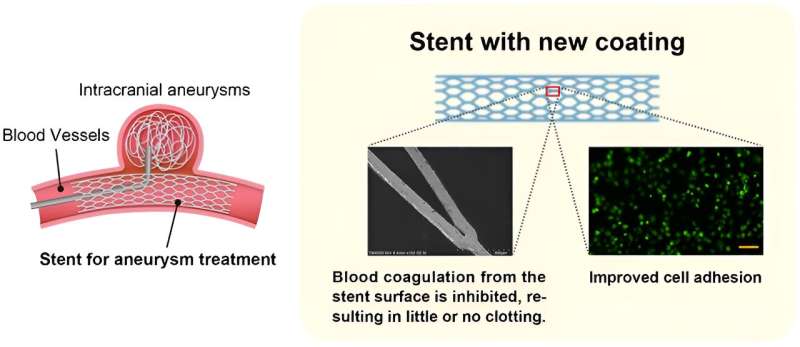This article has been reviewed according to Science X's editorial process and policies. Editors have highlighted the following attributes while ensuring the content's credibility:
fact-checked
peer-reviewed publication
trusted source
proofread
Scientists create novel anti-thrombogenic coatings to overcome endovascular therapy challenges

A researcher at AIST, in collaboration with the Japan Medical Startup Incubation Program (JMPR) and N.B. Medical Corporation, has developed a novel anti-thrombogenic coating for stents used in the treatment of intracranial aneurysms. The details of this technology were published in Scientific Reports on July 10, 2024.
In recent years, due to progress in medical equipment, minimally invasive endovascular treatment has become the mainstream in the treatment of intracranial aneurysms, the main cause of subarachnoid hemorrhage.
In particular, coil embolization with a stent has been reported to be highly safe and effective, and is now considered one of the most established endovascular treatment methods. However, this technique carries the risk of vascular occlusion due to thrombus formation caused by the blood incompatibility with stent, and antiplatelet medication is mandatory.
Many antithrombotic coatings have been investigated to reduce the risk of thrombus formation. However, while conventional polymers inhibit thrombus formation, they have the disadvantage of inhibiting the coverage of the stent with the vessel, known as endothelialization, which is associated with cell adhesion.
In stent-based therapy, healing is complete when the stent undergoes complete endothelialization. However, if cells fail to adhere, the endothelialization hardly occurs, delaying stent coverage with the vessel, leading to the risk of delayed healing. This leads to a vicious cycle in which antiplatelet medication period is prolonged, further increasing the risk of bleeding complications.
For this reason, there has long been a need in the clinical setting for coating technologies that have antithrombotic properties with cell adhesion without inhibiting endothelialization. However, these two properties are contradictory, and no coating materials with those two properties have been available.
The researchers found an anti-thrombogenic coating with a new principle. This technology preferentially captures non-coagulant proteins in the blood, thereby inhibiting the blood coagulation reaction from the stent surface due to the blocking effect.
This technology, which controls rather than inhibits the protein adsorption, provides anti-thrombogenic properties while simultaneously improving cell adhesion. The improved cell adhesion can accelerate the coverage of the stent with the vessel. The early coverage of the stent with the vessel means earlier completion of the stent therapy.
This technology reduces the occurrence of thrombotic complications, which have been an issue with stent therapy. Furthermore, it enables reduction of the treatment period, and thereby, the amount of antiplatelet drug use can be lower, which not only reduces the burden on patients, but also contributes to the medical cost cut.
More information: Naoki Inuzuka et al, Stent coating containing a charged silane coupling agent that regulates protein adsorption to confer antithrombotic and cell-adhesion properties, Scientific Reports (2024). DOI: 10.1038/s41598-024-65832-5

















